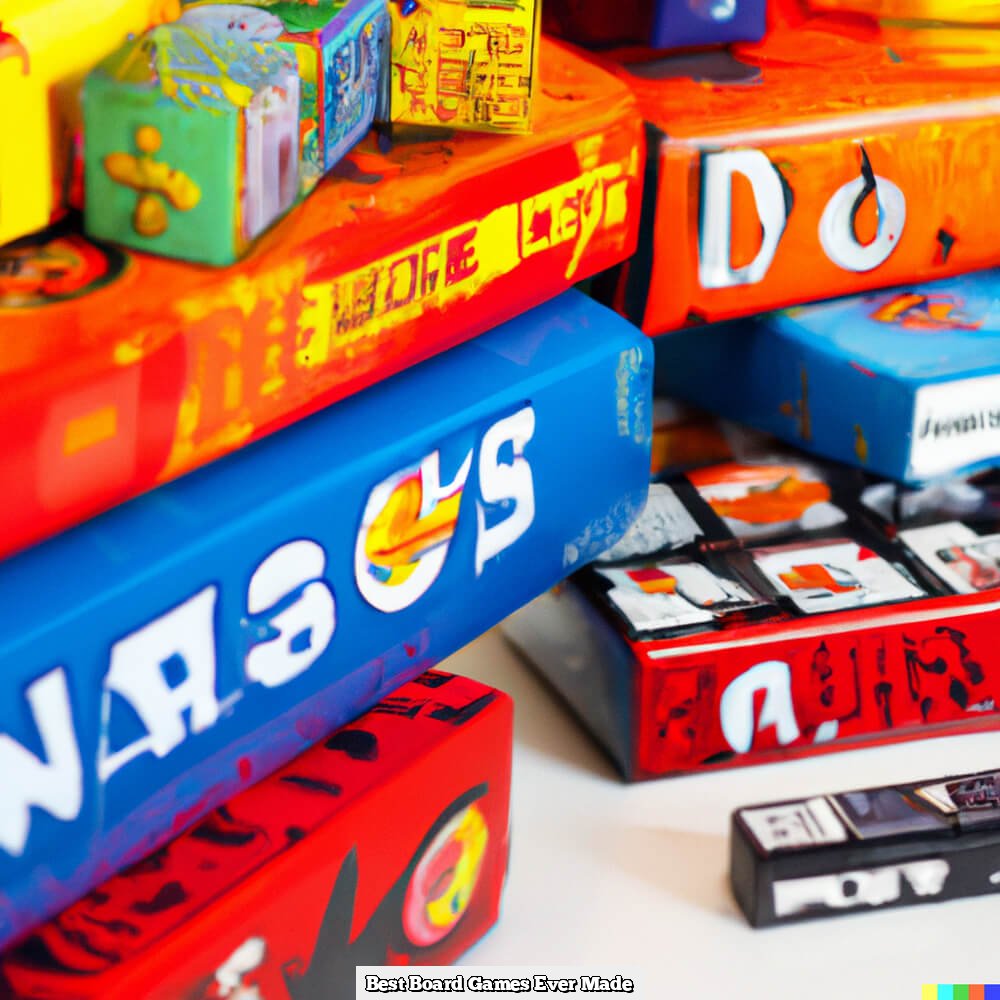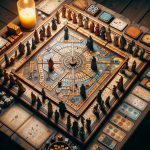Introduction to Board Games
The history of board games goes back to ancient times, with some of the earliest versions originating in Ancient Egypt. The Egyptians are believed to have been the first people to produce and play board games, creating early forms of checkers or draughts as early as 3,000 BC. This was around the same time as they were also inventing some of their most impressive structures like the pyramids.
It is not known exactly when individual board games were invented but by 1500 BC there is evidence that distinct games were being played in several different parts of the world. In North America, a version of Mancala was likely one of the most popular among indigenous groups while backgammon originated in Mesopotamia (modern-day Iraq) and various other game pieces have been discovered in archaeological digs across Europe and Asia Minor. Interestingly, some recognizable variations on many modern-day classics like chess appeared as works of art in medieval European paintings from as far back as the 12th Century.
From these primitive beginnings, board games continued to develop throughout history and eventually spread across cultures due largely to trade and exploration. By the 19th Century, some simpler editions had become reasonably popular enough for mass production but it was still several decades before any kind of mass scale distribution system really took hold to make it possible for everyone to buy a set whenever they wanted one. Eventually, technologies such as Industrial lamination and cardboard printing would revolutionize mass production on items such as cards and boards making them accessible for practically anyone regardless of geographic location or social status.
The Beginnings of Board Games
The first board games can be traced back to ancient Egypt around 3,500 B.C. Archaeological evidence of these early board games includes game pieces carved from ivory, and dice that were used in a game called Senet. At the same time, people in China played an early version of Go called Weiqi (or “encirclement”) using black and white stones; this game is still popular today.
The Mesopotamians, living between the Tigris and Euphrates Rivers in what is now Iraq and neighboring countries, also played various board and stone-based games around 4,000 B.C., such as The Royal Game of Ur. Pieces for this game were discovered at the ancient Sumerian city of Ur by British archaeologist Sir Leonard Woolley in the 1920s. The rules for playing these early board games, however, have been lost over time.
Later on you find examples of more complex board games such as Mancala originating in Africa between 800″1400 A.D., Backgammon ” a Middle Eastern game believed to have originated around 5,000 years ago with archaeological artifacts found dating back to 3000 B.C., Chess originated in India sometime before 600 A.D., Checkers – a game derived from Alquerque which was most likely invented around 1200 A.D., and more recently Pachisi which appeared around 1620 A.D..
In addition to these historical classics, modern board games continue to gain popularity worldwide with games such as Monopoly (1935), Scrabble (1938), Risk (1959) and Settlers of Catan (1995). This shows that although some may have settled for traditional strategies throughout history; others are constantly looking for innovative ideas when it comes to developing new challenging entertainment experiences involving other players sharing fun moments together over a board game!
Prehistoric Board Games
Evidence suggests board games have been around since prehistoric times. Excavations at various archaeological sites have yielded a variety of objects that indicate early humans and even Neanderthals may have played an array of primitive board games. Examples of artifacts found include animal-shaped stones, flat pieces resembling those used to play checkers and simple gaming boards engraved into stone slabs.
The use of games as entertainment and learning tools is believed to have originated long before written history in the form of ritualistic mental sports or ritualized physical challenges such as handball and running races. Ancient Egyptians were also known to engage in a wide range of simpler board games such as Senet, a two-player strategy game which used gaming pieces said to represent visible stars. This game was widely played throughout early Mesopotamia by both civilizations and royalty, which often owned impressive sets made from expensive materials like ebony wood or gold leaf.
It wasn’t until much later – possibly around 4000 BC – that we begin to find evidence for more complex forms of multi-person board games, with fragments of well-used gaming pieces found at archaeological sites in what is now the southern Levant region (modern Iraq and Syria). This led to the invention of many new variants on Senet over the following millennia, including Tabula (said to be Julius Caesar’s favorite game) and Nine Men’s Morris, which by medieval times had become popular across Europe and Asia. By the 1800s when mass production made die-cast metal Game Pieces common, board games began entering homes all over the world, creating generations’ worth of shared memories.
Ancient Board Games
The origin of board games is far from certain, with evidence indicating they have been around since at least 5000BC. Historians believe that some of the earliest known board games were made by early civilizations living in Mesopotamia and Egypt. These cultures used primitive game boards to teach basic mathematics and logistics principles, allowing them to train their minds and create strategy through simulated warfare.
Over the centuries, these founding games evolved into more complex creations with intricate playing pieces and rules. By 500 BC, civilizations began making elaborate ‘wooden patterned boards’ often used for religious or societal purpose as well for entertainment. Further refinements continued throughout the ancient East Asian civilization era with many new board games created during this time, including Awari (from West Africa in 500 AD) Go (from China) and Shogi or Japanese Chess (which predated international Chess).
At this time, these ancient board games also started to travel along trade routes spreading across regions such as India and Southwest Asia into Europe where they became increasingly varied according to regional culture’s particular styles of play. Well-known European variants included The Royal Game of Ur from Mesopotamia, Hnefatafl from Scandinavia, Fox and Geese from Germany and various versions of Backgammon that can be found throughout Europe today.
In addition to traveling via trade routes, ancient board game pieces were transferred through cultural influences as teaching tools passing down traditions which can still be seen in modern times. Meanwhile over in East Asia particularly Japan the refinement of traditional board games like Go continued starting a legacy that is still alive today with competition events held regularly around the world.
Medieval Board Games
The creation and play of board games have evolved significantly since the Middle Ages. Primarily, board games were used by adults to hone their skills and occasionally pass time in the absence of other activities. One of the earliest known board games was the Moroccan game called “Shatranj” or “Chatrang”, which dates back to 7th Century AD. This two-player strategy game was an ancestor to modern day Chess, and is believed to have been played on checkered boards using dice and counters as pieces.
During the Middle Ages, board games became deeply embedded in popular culture and there was a significant increase in production activity across Europe. This period saw a rapid development of new types of gameboards that included complex three-dimensional designs, geometric patterns with added features for depicting landscapes, castles, towns and ships. These boards often tripled as gaming surfaces as well as storage areas for decorative carved pieces which were usually made from bone or ivory.
New rules developed during this time which aimed to enhance the gaming experience even further. In particular, specific rules were introduced for particular types of board games such as Alquerque (an ancient battle game) and Tablut (similar to modern day Tic-Tac-Toe). It is believed that around 1486CE a compilation book was published that featured over 200 distinct rules regarding various kinds of checkerboard games. The wealthy classes began using their wealth to commission ornate customised boards while other less privileged classes began purchasing cheaper versions fashioned out of wood or leather instead. Game playing among all classes during this time resulted in numerous benefits such as hand-eye coordination improvement, enhanced ability to think strategically before making decisions and improved problem solving skills.
Renaissance Board Games
The earliest known board games can be traced back to ancient Mesopotamia, almost 5000 years ago. In the beginning, board games were created for children’s entertainment as well as to teach religious and moral values. The Egyptians are credited with creating the most iconic of these early board games, Senet. Senet involved a movable board with squares marked with hieroglyphs, two players, and various pieces that players moved around the board.
During medieval times, several variations of chess emerged across Europe, becoming an extremely popular pastime among wealthy members of society. This guild-like enthusiasm for gaming spread quickly into other areas of life throughout the Renaissance period in European history. The game genre blossomed both figuratively and literally during this era with an array of exotic new games being created and placed on sale in markets by traveling merchants from country to country. Popular Renaissance board games included Mancala”an African-origin game played with marbles”Backgammon which originated from Persia and Nine Men’s Morris”a strategy game believed to have been devised prior to 1400 AD in England.
Today, a number of these ancient pastimes have outlasted the ages and continue to provide fun entertainment in living rooms around the world while others stand as testament to the ingenuity of humanity’s traditional hobbies. Whatever their origins may be or purpose they served, it is nonetheless clear that centuries ago people sought out outlets such as board games”where they could employ their best strategies and exercise their minds in an entertaining fashion.
Modern Board Games
The first modern board games can be traced back to the 19th century Europe. The emergence of popular titles like Ludo, Pachisi, Mancala and Checkers marked the start of a long history of gaming worldwide. Historians believe that these classic titles were adapted from much older predecessors like Alquerque and Senet, which can be traced all the way back to 3500 BC in Egypt. These boards include squares used for playing games with dice or counters, and the board would indicate what sort of strategy was needed to win the game.
As times changed in the 20th century and new generations brought in different cultural influences, so too did modern board games develop. Today’s titles often incorporate elements from many different cultures along with pieces that are highly stylized. Complex theme-based games such as Monopoly or Risk also became extremely popular during this era due to their tactical approach to play. In more recent times we have seen an explosion of niche indie titles making their way onto store shelves ” allowing gamers to discover genres such as strategy, horror and trivia style games with ease. Regardless of their origin or subject matter, all modern board games remain indebted to their ancient predecessors for introducing us to something that continues bring family and friends together for hours of amusement and entertainment!
Reflections
The exact answer to when the first board games were made is unknown, as gaming has been around for millennia. There are records of ancient games from all over the world, such as chess in India (around 600 AD) and senet in Egypt (around 3100 BCE). The oldest known board game pieces discovered to date were found in Iraq and date back over 5,000 years.
Despite this long history, board games have constantly evolved and changed over the centuries. Every culture has refined the various components that make up a game based on their own beliefs and traditions. For example, “Go” – an abstract strategy game developed in China between 2-3 thousand years ago – inspired European settlers to create their own versions of this type of game using different playing pieces as early as 1700’s. This is why many modern well-known classic games still adhere to some form of “Go” elements found within them.
The reason board games have continued to stand the test of time is mainly due to how enjoyable they can be for both amateur players and experts alike. Each one allows for hours of strategic problem solving captured within its rules ensuring the player experience remains fresh upon each play session; helping them to stay popular even today. This level of engagement not only supports social interaction among players by providing something fun for everyone but also encourages further development if so desired with new dedicated non-digital add-on memberships or expansions existing across various themes ranging from space exploration, adventure and fantasy genres.

I love playing all kinds of games – from classics like Monopoly to modern favourites like Ticket to Ride.
I created this blog as a way to share my love of board games with others, and provide information on the latest releases and news in the industry.





